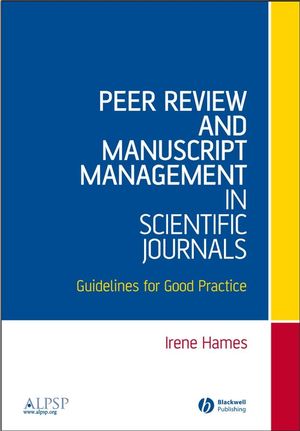Peer Review and Manuscript Management in Scientific Journals: Guidelines for Good PracticeISBN: 978-1-4051-3159-9
Paperback
306 pages
April 2007, Wiley-Blackwell
 This is a Print-on-Demand title. It will be printed specifically to fill your order. Please allow an additional 15-20 days delivery time. The book is not returnable.
|
||||||
“By writing a book on peer review and manuscript management, Irene Hames has helped millions of readers, thousands of authors and hundreds of reviewers and editors to reach a higher standard for scientific publications. I benefited greatly reading the book and warmly suggest every scientist to have it available as a reference book on his or her book shelf when thinking about putting together a manuscript or when invited to serve the community as a reviewer.” (Journal of Sedimentary Research)
"Hames’ aim is to provide a manual to help editors, their editorial colleagues, and staff, and to give practical guidance on all aspects of peer review, creating an awareness of the issues involved and potential problems. This she has achieved, taking the reader from manuscript submission, through the peer review process, to decision making… [Included are] some 80 pages of appendices. These extremely useful checklists, forms, guidance, and sample letters provide salient information, and act as an excellent resource for all involved in the publication of scientific journals. Hames offers essential instruction for editors at all levels. Reviewers, even authors, would profit from reading this book. But it will be of most use to those starting a new position in the publication of scientific journals; from academic Editor-in-Chief to Editorial Assistant, it should be prerequisite reading." (The Lancet)
"… this comprehensive, authoritative, and useful book represents a precious resource for would-be editors wishing to learn every aspect of manuscript management and peer review. Established journals wishing to review and update administrative practices, and even authors and peer reviewers may find it helpful and informative on many aspects of the work performed in editorial offices, which often is shrouded in mystery." (Journal of the American Medical Association)
"...a timely and well-informed book. Newly appointed editors
will find masses of useful information and practical tips. Seasoned
editors will be inspired to reassess and refine their own
procedures." (Polar Research)
“An excellent and must-read book for journal editors … It will also serve as a valuable resource for anyone interested or involved in the peer-review process.” (PsycCritiques)
"Irene Hames....writes engagingly, and, from the viewpoint of her extensive experience, provides a practical handbook that describes ways of coping with the many day-to-day problems that must be faced by the editor and office staff of a scientific journal...I strongly recommend it..." (Editing Matters)
“A godsend to the rookie editor taking the driving seat for the first time and feeling understandably daunted by the responsibility. Statements like ‘no editorial office should be without it’, ‘an essential resource’ or ‘indispensable’ unfortunately sound like clichés. In the case of this book, however, they are all true. In fact, I think I will need a second copy for when one of my colleagues pinches this one!”–Stuart Taylor (Head of Publishing, The Royal Society), Book Review in Learned Publishing
“In the midst of the often overheated current debates
about the effectiveness of peer review in science publishing, this
book is an oasis of calm. I know no better guide for editors and
scientists on how to get the very best out of the peer review
system.”
–Andrew Sugden, International Managing Editor,
Science
"The development of editorial office best practices, couched
within an understanding of the fundamental principles of peer
review, has been neglected for too long. With the publication of
this book, light has been shone on a dark corner of publishing.
Only now is the industry beginning to address the somewhat amateur
status of most editorial offices and an associated dearth of
training opportunities. This book represents an excellent attempt
at providing a procedural grounding in efficient manuscript
management, while offering context for these fundamental
administrative principles. It is no overstatement to suggest this
book will act as a catalyst to introduce greater professionalism
alongside definitive operational theories to the typical journal
editorial office. Editorial office staff, both new and experienced
alike, will find this book invaluable."
–Jason Roberts, PhD, President, International Society of
Managing and Technical Editors
“This highly practical book… will undoubtedly become
the 'bible' of peer review, not only for those working in the
sciences but also for those in the arts and humanities. No editor
or publisher should be without it.”
–Robert Campbell, Wiley-Blackwell and Sally Morris,
Association of Learned and Professional Society Publishers



